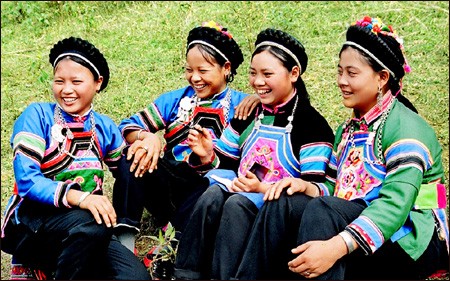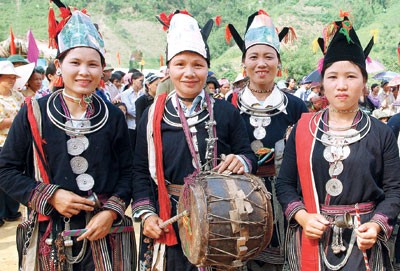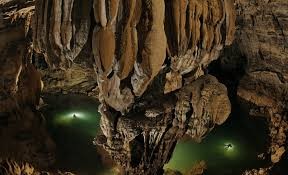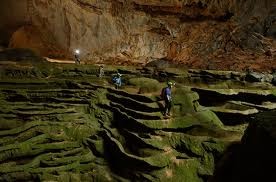Hello and welcome to VOV’s Letter Box, our weekly feature dedicated to our listeners throughout the world. We’re Mai Phuong and Ngoc Huyen
A: This week, we continued to receive a lot of letters from our listeners from all over the world. Most of the listeners wrote that they especially liked our features about Tet traditions, customs and Tet celebrations among different ethnic minority groups in Vietnam.

Bo Y ethnic minority group |
B: Alan Roe of the UK, in a letter to VOV this week, wrote: “Thank you for an enjoyable and interesting program about the Spring festival, and especially the “Do’s and Don’ts” for receiving good luck through the New Year- very interesting. I have also continued to enjoy your series “Colorful Vietnam- Vietnam’s 54 ethnic groups” and the fascinating current series of programs about the Ede people. This is great programming and I do recommend to others that they listen to this series”.
A: Alan said he particularly liked the story about the Mong ethnic people’s custom of buttock slapping, adding that he couldn’t resist going to the VOV archive of programs to listen to this story again.
B: Thank you Alan for your comments about our programs, especially those about ethnicity in Vietnam. Vietnam is the fatherland of many ethnic groups,, as well as legends about the children of Lac Long Quan - Au Co, who gave birth to one hundred children, half of them going with the mother up to the mountains and half went with the father down to the sea, which expanded the mountains and rivers
A: These ethnic groups have different cultures, traditions and customs. With different natural geographic conditions (geomorphology, land, climate), ethnic groups have sought different methods of living with nature.

Dao ethnic minority people |
B: In the plains and midlands, ethnic groups grow water rice, as they build the culture of villages and hamlets by placing communal houses in the center, along with a well and banyan trees, surrounded by green, thorny bamboo trees. These plain, farming villages are the source of inspiration, as is the "power" of loose-fitting blouses, as well as the pink blouse and conical hat, along with the melodies of the velvety folk-songs and high-pitched South folk-songs heard in the Mekong River Delta.
A: Down in the mountainous areas, ethnic groups grow water rice in combination with the planting of rice in fields, along with maize. At first, they planted long-term industrial trees (anise, cinnamon tree), to replace the natural forests. They live in houses built up on stilts, wear indigo-colored dress trousers, dresses, and shirts displaying forest flowers and animal designs. Ethnic minorities often have been known for drinking out of wine jugs through pipes, which is an example of their rich community traditions. Drinkers have a fondness for the heady bouquet of alcohol and a love of the human spirit.
B: Dear listeners, and Alan in particular, stories about Vietnam’s 54 ethnic groups seem to be endless and it will take time for you and us to discover more about them. I hope you are always with us in this long, interesting journey of exploration.
A: Sharing his impressions about the Tet programs on VOV, Harold Woering from the US said he really enjoyed listening to how Vietnamese people celebrate Tet, saying that the programs were very informative. Harold sent us a beautiful photo of Easthampton and reported listening to our program on February 4 on the 6175 Khz frequency, with a very good signal with a SINPO of 55445.
B: This week, we were happy to receive a long letter from Otto Schuwartz from the USA, who listened to our programs on January 9th, 31st and February 6th. Otto wrote: “As always, I enjoyed your programs very much. I found your reports and features about Tet, its traditions and customs, very interesting and informative. Whenever I hear the word Tet, it brings back memories of the Tet offensive, which marked the beginning of the end of America’s involvements in the Vietnam war”.
A: Thank you Otto for tuning in to our programs. From Indonesia, Tjang Pak Ning sent us reception reports on several programs in January and February, and we will send our QSL cards to confirm. In an email, Tjang Pak Ning said he is interested in learning about Vietnam’s Son Doong Cave, the World's largest cave, discovered in 2009.
B: Son Doong cave is located in Quang Binh province, Vietnam. It was found by a local man named Ho Khanh in 1991, and was explored in 2009 by British cavers, led by Howard Limbert. The name "Son Doong" cave means "mountain river cave". It was created 2-5 million years ago by river water eroding away the limestone underneath the mountain where the limestone was weak, and the ceiling later collapsed, creating huge skylights...

Son Doong cave |
A: Son Doong cave is more than 200 meters wide, 150 meters high, and approx 9 kilometers long, with caverns large enough to fit an entire city street inside them, being twice as large as Deer Cave in Malaysia (currently considered the world's largest at 90 meters wide, 100 meters high and 2 kilometers long). Son Doong cave was classified as the largest cave in the world by the British Cave Research Association and selected as one of the most beautiful caves in the world by the BBC news.
B: Son Doong cave is hidden in rugged Phong Nha- Ke Bang National Park in Quang Binh province near the border with Laos, the cave is part of a network of some 150 caves, though many have still not been surveyed. It is very difficult to travel in the caves. During the first expedition, the team explored two and a half miles of Son Doong cave before a 200-foot wall of muddy calcite stopped them. They named it the Great Wall of Vietnam. Above the mud, they could make out an open space and traces of light, but they had no idea what lay on the other side. One year later, they have returned—seven hard-core British cavers, a few scientists, and a crew of porters - to climb the wall, if they can, measure the passage, and push on, if possible, all the way to the end of the cave.

Son Doong cave |
A: That’s a short take about Vietnam’s Son Doong cave, the world’s largest cave. It would be a nice experience to explore the cave by yourself. So, plan to visit Vietnam some day in the future! Give us a call then.
B: This week, we’d like to welcome back to VOV Pradib Chandra Kundu of India, who resumed writing to us after a gap of over 30 years. Pradib wrote: “During 1980-86, when I was young, I used to be a regular listener of VOV English Programs and wrote to you frequently. But struggling for a career took me away from my hobby of radio Dxing. Now, last night, I suddenly had the opportunity to tune in to your English Program on shortwave 7280 Khz at around 1900 hrs UTC”.
A: Well, it’s nice to hear from you again, Pradib. Thank you for coming back and we hope you find our programs even more interesting and informative than before.
B: Finally, in the last minutes of VOV’s Letter Box, we’d like to acknowledge letters and emails from Micheal Gustafsson and Christer Brunstrom of Sweden, Takao Mizuike, Ian Morrison and John Rutledge of China, Mahfuzur Rahman, Ashik Eqbal Tokon of Bangladesh, Shri Bhagwan Sharma of India, Alan Fenix of the US, Hans Verner Lollike of Denmark, and Bhaikan Hazarika and Mahamad Aslam of India. We’ll verify your reception reports and send you some QSL cards soon.
A: That’s it for this week’s Letter Box. We welcome your feedback at: English Section, Overseas Service, Radio the Voice of Vietnam, 45 Ba Trieu Street, Hanoi, Vietnam. Or you can email us at: englishsection@vov.org.vn. You’re invited to visit us online at www.vovworld.vn, where you can hear both live and recorded programs. Good bye.